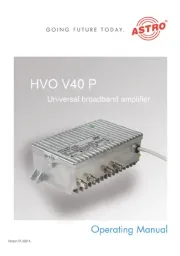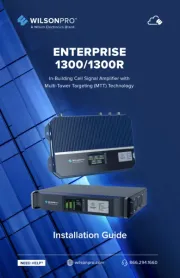Mikrotik LHG LTE kit Handleiding
Mikrotik
Signaalversterker TV
LHG LTE kit
Bekijk gratis de handleiding van Mikrotik LHG LTE kit (4 pagina’s), behorend tot de categorie Signaalversterker TV. Deze gids werd als nuttig beoordeeld door 67 mensen en kreeg gemiddeld 4.2 sterren uit 34 reviews. Heb je een vraag over Mikrotik LHG LTE kit of wil je andere gebruikers van dit product iets vragen? Stel een vraag
Pagina 1/4

LHG LTE kit
Assembly
Attach the two legs to the LHG case by sliding them onto the respective sides (when looking at the logo, leg
marked R is for the right side, leg marked L is for the left side). Snap the assembled LHG unit to the grid in the
appropriate central location. Fix the two legs in place with two self thread screws (included, use Phillips screw
driver PH2). The package also contains a grounding cable connector and a 5 degree angle adapter, for easier up or
downward tilt adjustment.
Quick start
1. While holding the unit by it’s central column, apply force to the tab, which holds the latch closed,
until the latch pops open.
2. Connect an ethernet cable to the ethernet port, connect the other end of the ethernet cable
to the included PoE injector.
3. Plug the PoE injector into your network switch or ISP internet outlet.
4. Plug the included power supply into the PoE injector to start up the device.
Powering
The device can be powered from 12-57 V 802.3af/at sources and also Passive PoE injectors (one power supply
and PoE injector are included).
Mounting
Slide the included metallic mounting rings into the two slots on the back of the antenna dish. Attach the unit to a
pole, with the Ethernet cable pointing downward. Use a PH2 screwdriver to tighten the rings. Fix the Ethernet cable
to the pole less than one meter from the unit, to avoid the cable being pulled out of the port. Optional: if required,
before mounting the unit, you can insert the included 5 degree adjustment adapter into the top or bottom slot where
the mounting ring is inserted. This will create an additional upward or downward angle, when the unit is tightened to
a vertical pole. Warning! This equipment should be installed and operated with minimum distance of 120 cm
between the radiator and your body,
Expansion slots and ports
One 10/100 ethernet port, supporting automatic cross/straight cable correction (Auto MDI/X). Either straight
or crossover cable can be used for connecting to other network devices. The ethernet port accepts 9-30 V
DC powering from a passive PoE injector.
miniPCIe slot and SIM slot (can’t be used separately) to be used with a 3G/4G/LTE modem (the LTE kit
includes the modem already inside the device).
Buttons and jumpers
RouterBOOT reset button has the following functions. Press the button and apply the power, then:
Release the button when green LED starts flashing, to reset RouterOS configuration to defaults.
Release the button when the LED turns solid green to clear all configuration and defaults.
Release the button after LED is no longer lit (~20 seconds) to cause device to look for Netinstall servers
(required for reinstalling RouterOS over network).
Regardless of the above option used, the system will load the backup RouterBOOT loader if the button is pressed
before power is applied to the device. Useful for RouterBOOT debugging and recovery.
The device includes a grounding connection behind the ethernet port door, which you should connect to the
grounding installation of the tower or building where the device will be used. This is to substantially reduce risk of
ESD and lightning damage.
See mikrotik.com for more information. Document #41960 Modified on: 07/03/18

Configuration
We recommend clicking the “Check for updates” button and updating your RouterOS software to the latest version
to ensure the best performance and stability. RouterOS includes many configuration options in addition to what is
described in this document. We suggest to visit the RouterOS documentation page to get yourself accustomed to
the possibilities: http://mt.lv/help.
In case IP connection is not available, the Winbox tool (http://mt.lv/winbox) can be used to connect to the MAC
address of the device from the LAN side (all access is blocked from the internet port by default).
It is possible to boot the device from network, for reinstalling RouterOS for recovery purposes. This can be done
from the Ethernet port. See above how to do this.
Operating system support
The device supports RouterOS software with the version number at or above what is indicated in the RouterOS
menu . Other operating systems have not been tested. /system resource
Opening the case
To access the miniPCIe modem, opening of the unit is required. As an opening tool you can use a large size flat
head screwdriver or a small coin. Be extremely cautious when opening, because incorrect opening of the clip can
break it off! Follow these steps:
See mikrotik.com for more information. Document #41960 Modified on: 07/03/18
Follow this order when opening the unit Insert a screwdriver into the first slot
Turn the screwdriver, until one side pops open.
Continue in the above order.
Lift cover to access the card.

Federal communication commission interference statement
R11e-LTE: FCC ID TV7R11ELTE, TV7R11E4G
This equipment has been tested and found to comply with the limits for a Class B digital device,
pursuant to Part 15 of the FCC Rules. These limits are designed to provide reasonable protection against harmful
interference in a residential installation.
This equipment generates, uses and can radiate radio frequency energy and, if not installed and used in
accordance with the instructions, may cause harmful interference to radio communications. However, there is no
guarantee that interference will not occur in a particular installation. If this equipment does cause harmful
interference to radio or television reception, which can be determined by turning the equipment off and on, the user
is encouraged to try to correct the interference by one of the following measures:
•Reorient or relocate the receiving antenna.
•Increase the separation between the equipment and receiver.
•Connect the equipment into an outlet on a circuit different from that to which the receiver is connected.
•Consult the dealer or an experienced radio/TV technician for help.
FCC Caution: Any changes or modifications not expressly approved by the party responsible for compliance could
void the user’s authority to operate this equipment.
This device complies with Part 15 of the FCC Rules. Operation is subject to the following two conditions: (1) This
device may not cause harmful interference, and (2) this device must accept any interference received, including
interference that may cause undesired operation.This device and its antenna must not be co-located or operation in
conjunction with any other antenna or transmitter.
IMPORTANT: Exposure to Radio Frequency Radiation. 20 cm minimum distance has to be maintained between the
antenna and user. Under such configuration, the FCC radiation exposure limits set forth for an
population/uncontrolled environment can be satisfied.
Antenna Installation. WARNING: It is installer's responsibility to ensure that when using the authorized antennas in
the United States (or where FCC rules apply); only those antennas certified with the product are used. The use of
any antenna other than those certified with the product is expressly forbidden in accordance to FCC rules CFR47
part 15.204. The installer should configure the output power level of antennas, according to country regulations and
per antenna type. Professional installation is required of equipment with connectors to ensure compliance with
health and safety issues.
See mikrotik.com for more information. Document #41960 Modified on: 07/03/18
Product specificaties
| Merk: | Mikrotik |
| Categorie: | Signaalversterker TV |
| Model: | LHG LTE kit |
| Kleur van het product: | Wit |
| Breedte: | 391 mm |
| Diepte: | 227 mm |
| Hoogte: | 391 mm |
| Soort: | Buitengebruik signaalversterker voor mobiele telefoons |
| Ethernet LAN: | Ja |
| Type stroombron: | Power over Ethernet (PoE) |
| Meegeleverde kabels: | AC |
| Aantal Ethernet LAN (RJ-45)-poorten: | 1 |
| Ingangsspanning: | 12-57 V |
| Ethernet LAN, data-overdrachtsnelheden: | 10, 100 Mbit/s |
| Antenne versterkingsniveau (max): | 21 dBi |
| Datanetwerk: | LTE |
| UMTS bands ondersteund: | 700,850,1700,1900 MHz |
| Reset button: | Ja |
| Wifi: | Nee |
| Bedrijfstemperatuur (T-T): | -40 - 60 °C |
| Uplink frequentie bereik: | - MHz |
| Downlink frequentie bereik: | - MHz |
| Uplink winst: | - dB |
Heb je hulp nodig?
Als je hulp nodig hebt met Mikrotik LHG LTE kit stel dan hieronder een vraag en andere gebruikers zullen je antwoorden
Handleiding Signaalversterker TV Mikrotik

13 April 2023
Handleiding Signaalversterker TV
- Velleman
- Wilson
- Hager
- Winegard
- RCA
- Epcom
- ZBoost
- Hama
- Technisat
- Wilson Electronics
- HQ
- Goobay
- Asus
- Triax
- SmoothTalker
Nieuwste handleidingen voor Signaalversterker TV

12 Februari 2025

7 December 2024

3 December 2024

19 November 2024

19 November 2024

19 November 2024

19 November 2024

19 November 2024

19 November 2024

19 November 2024